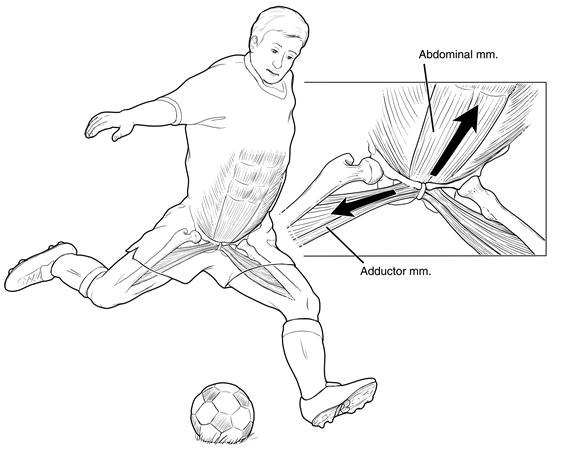Chronic Aseptic Osteitis Pubis is a complex and debilitating condition that poses significant challenges in the medical field, particularly in sports medicine. This condition is characterised by chronic pain and inflammation in the pubic symphysis, the joint at the front of the pelvis. The pathophysiology of Osteitis Pubis is not completely understood, but it is generally attributed to repetitive stress on the pubic bones, leading to an overuse injury. This stress can be due to various factors including sports injuries, surgical procedures, childbirth, or even certain types of physical activities.
The pubic symphysis is a non-synovial amphiarthrodial joint, which means it allows only slight mobility. It is a fibrocartilaginous disc sandwiched between the two pubic bones. In the case of Osteitis Pubis, this area becomes inflamed and painful, often radiating pain to the surrounding muscles and tissues. The condition is typically diagnosed through a combination of clinical examination and imaging techniques like MRI or bone scans, which help to rule out other causes of groin pain such as hernias or fractures.
The traditional approach to treating Osteitis Pubis has been conservative, focusing on rest, physical therapy, and pain management through medications. However, these methods can be slow and don’t always yield effective results, especially in chronic cases. This has led to a search for alternative therapies.

The study by Klüter et al., published in 2018, presents an intriguing advancement in the treatment of Chronic Aseptic Osteitis Pubis. The research focused on Electromagnetic Transduction Therapy (EMTT) as a potential treatment. EMTT is a relatively new, non-invasive therapeutic approach that uses electromagnetic fields to stimulate healing processes in the body. The therapy is believed to promote tissue regeneration, reduce inflammation, and alleviate pain.
In this study, nine sport-active patients who had not responded to traditional conservative therapy were selected. These patients represented a critical group, as Osteitis Pubis is particularly prevalent among athletes, especially those involved in sports that require repetitive pelvic movements, such as soccer, hockey, and running. The chronic nature of their condition meant that they had been dealing with pain and functional limitations for an extended period, significantly impacting their quality of life and athletic performance.
The treatment protocol involved the use of the Storz EMTT device, which was applied for four sessions over a period of two weeks, with two sessions per week. This approach was designed to test the efficacy of EMTT in reducing pain and improving function in a short period.
The results of the study were promising. Pain levels were quantitatively measured using the Visual Analogue Scale (VAS), a standard tool in pain assessment that allows patients to rate their pain on a scale of 0 (no pain) to 10 (worst possible pain). At the onset of the study, the average VAS score was 7.5 ± 1.0, indicating significant pain. Following the two weeks of EMTT treatment, there was a substantial reduction in pain, with the post-treatment VAS score dropping to an average of 0.5 (± 0.72). This marked reduction in pain was not just temporary; three months after the treatment, all patients reported a VAS score of 0, suggesting a sustained benefit from the therapy.
Moreover, the study reported that all patients were able to return to work the day after the final EMTT session, indicating an immediate improvement in functional capacity. Most patients also returned to sports activities within two weeks, a significant outcome given the chronic nature of their condition and their previous unresponsiveness to conservative treatments.
The absence of major side effects from EMTT treatment in this study is also noteworthy. While patients were allowed to continue their pre-existing analgesic medication during the treatment period, the lack of severe adverse reactions underscores the safety of EMTT as a therapeutic option.
This study is significant for several reasons. Firstly, it offers a new, effective treatment modality for Chronic Aseptic Osteitis Pubis, a condition that has been traditionally difficult to manage. The ability of EMTT to provide rapid and sustained pain relief, coupled with the enhancement of functional abilities, is particularly beneficial for athletes and individuals engaged in physical occupations. Secondly, the study opens up avenues for further research into EMTT’s applications in other musculoskeletal conditions. The mechanism by which EMTT alleviates pain and inflammation could have implications for the treatment of similar overuse injuries or chronic musculoskeletal disorders.
In conclusion, the study by Klüter et al. represents a significant advancement in the management of Chronic Aseptic Osteitis Pubis. The findings suggest that EMTT is a safe, effective, and rapid treatment option for this challenging condition, especially in cases where conventional therapies have failed. This research not only provides new hope for individuals suffering from this condition but also adds a valuable tool to the arsenal of treatments available for chronic musculoskeletal disorders. The implications of these findings extend beyond immediate pain relief, offering potential for enhanced recovery times, improved quality of life, and a quicker return to normal activities and sports for those affected.
Benoy Mathew, MSc, MCSP,
Advanced Practice Physio,
Head of MSK Education, Venn Healthcare
Twitter: @function2fitness
Instagram: @function2fitness
Reference:
Klüter, T., Ringeisen, M., Krath, A., Al Muderis, M. and Mittermayr, R., 2018. Electromagnetic Transduction Therapy in Patients with Chronic Aseptic Osteitis Pubis. J Orthop Ther: JORT-1113. DOI, 10, pp.2575-8241.




